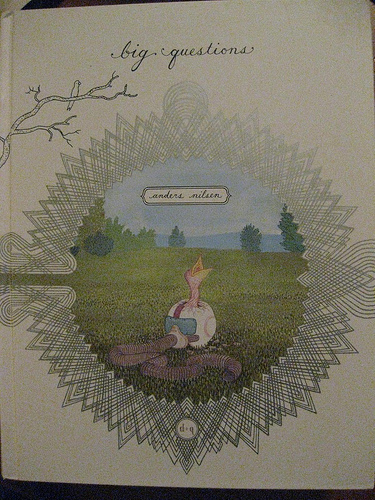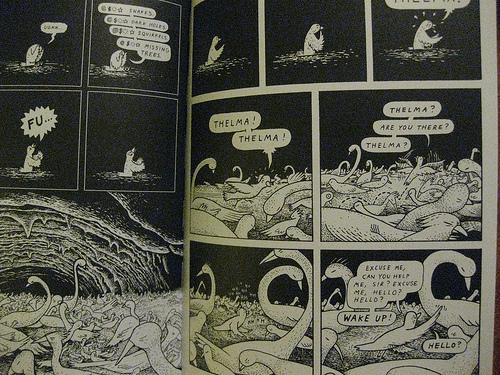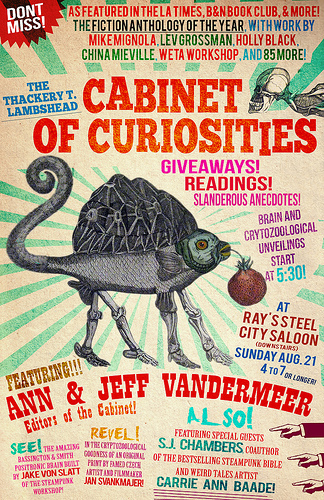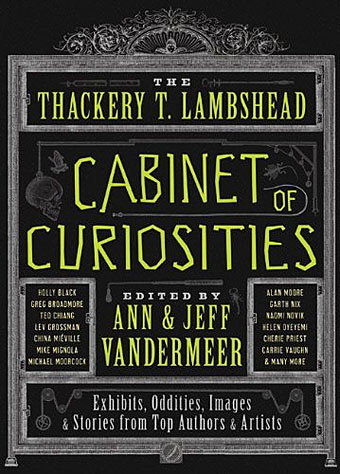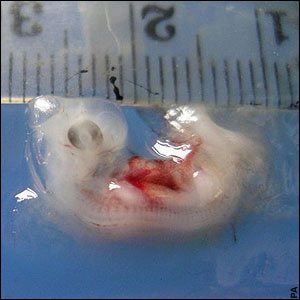Jeff VanderMeer's Blog, page 48
August 18, 2011
Book Lover's Quest: Big Questions by Anders Nilsen Needed Big Book–Huge, Glorious, Awesome Book!
Big Questions by Anders Nilsen and I have had only a passing acquaintance until now…when the awesome Drawn & Quarterly Press decided to drop a metric ton on me in the form of a huge hardcover book that has been lovingly and exquisitely designed. Wow wow wow—absolutely beautiful in all possible ways.
and I have had only a passing acquaintance until now…when the awesome Drawn & Quarterly Press decided to drop a metric ton on me in the form of a huge hardcover book that has been lovingly and exquisitely designed. Wow wow wow—absolutely beautiful in all possible ways.
Huh? Wha? Why? Who? say those amongst you who care not for the tactile creativity that is a well-designed book printed on a real honest-to-god offset press as opposed to in html e-purgatory.
Let me then take you through a little guided tour of how the pleasure centers of the book lover's brain light up when encountering this kind of artifact, especially so unexpectedly…
Whoa! Cool endpapers—and a creatively tipped-in faux cover flap for a splash of color and surprise, and to appease those who prefer dust jackets to covers printed right on the boards. Nice touch.
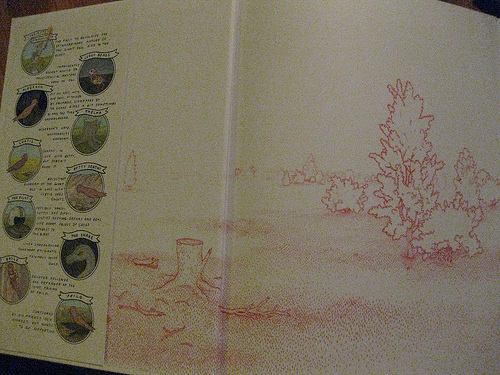
Focusing on the front cover flap to admire the detail work and the sharpness of the color…it's like they're a dozen expensive chocolates…except they're images on a flap.
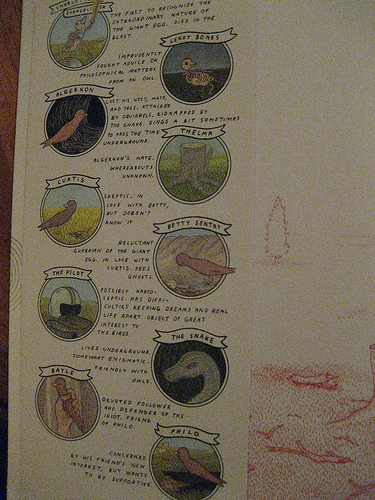
OMG OMG—there's a signing page and this is a limited edition. OMG. *Checks pulse to make sure not going over the limit for a man of 43 years of age.* Spends a long time just admiring this page…
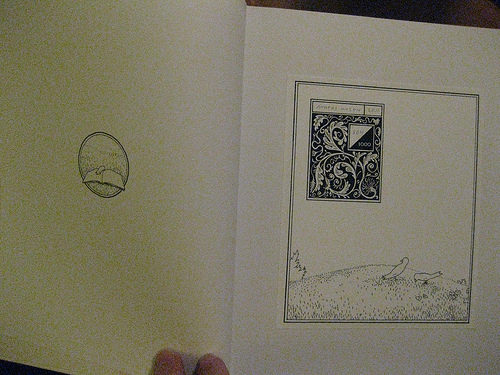
Recovers slightly while viewing the full title page, which displays smart, savvy design and good use of the available space.
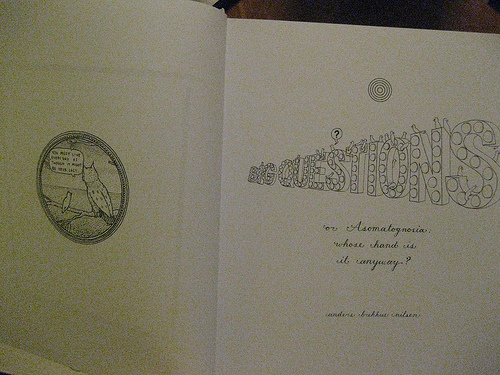
Pulse rises slightly again on seeing the table of contents: the harbinger of all that is awesome within the book, and, again, smartly designed.
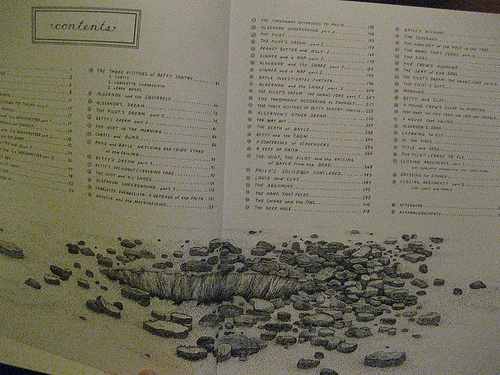
Oooh, nice interior art—bold and interesting–although this squirrel ass-kicking panel I'm reproducing here mostly in honor of my friend Larry Nolen…
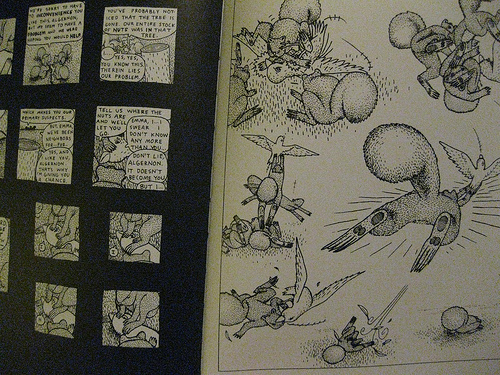
More awesome art, occupying the interstices between the real and the surreal…now salivating at the thought of sitting down with the book to read it at my leisure, while also vaguely entertaining the notion of buying a paperback version and slip-casing this limited hardcover so as not to get oily fingerprints on it, or in any other way damage it…
WTF. An afterword, too?! Bless my stars and whiskers! What other end matter treasures await me?!

Um, pulse rising again, sharply, as I encounter Appendix A. Oh happy happy joy joy because even as I'm poring over the treasures of this appendix I am thinking to myself "It doesn't end here, it doesn't end here…because where there is an Appendix A, surely surely there must be an…"

"…Appendix B!" SQUEEEE! In full-color.

Squuuueeeeeeeeee! Reduced to a brain-exploded exhausted ripple of pure book-lovers' bliss….

The back cover is the requisite dying fall, allowing the book admirer to think back with admiration, and a certain measure of restored calm, on the care and skill expressed through the book's design. Along with the thought: this one is going on a bookshelf reserved for the best…

Book Lover's Quest: Big Questions by Anders Nilsen Needed Big Book–Huge, Glorious, Awesome Book! originally appeared on Ecstatic Days on August 18, 2011.




Cabinet of Curiosities Extravaganza: The Poe-Bug; Dr. S. J. Chambers Explains
In honor of the Tallahassee Lambshead Cabinet Extravaganza occurring this Sunday at Ray's Steel City Saloon (info here), I'll be posting some special new material connected to the anthology (order it here!).
First up is contributor S.J. Chambers' rumination on Poe-pathy, associated to some degree with her contribution to the Cabinet antho, Dr. Lambshead's Dark Room. The account of meeting Dr. Lambshead concerns hypnotic techniques, including the Valdemar Method, which enabled the doctor "to extract from even the most cavernous subconscious those diseases that afflicted the soul, as demonstrated in the mesmeric stories of Edgar Allan Poe."
Tomorrow: An expanded treatise on the famed "Ear-Eye"!
THE POE BUG
S.J. Chambers
Have you experienced these following symptoms: soaring soul, existential exigency, speaking in cryptically symbolic metaphor, vertigo caused by sublimity, vision heightened by chiaroscuro, dead-dwelling or head-swelling? Do you suffer from daydreaming reflex with reveries that include blackbirds, scents of an unseen censor or aberrant alliterative applications? If you have answered yes to more than one of these, you may be suffering from Poepathy. A terrible disease of the soul, characterized by the affectation of the imagination and its degenerate interaction with the secular world, Poepathy is derived from continual contact of the reader's imagination with that of 19th- century American author, Edgar Allan Poe, and the dependency upon Poe's work for constant creative stimuli.
Not everyone who reads Poe's stories contracts Poepathy; only a select few possess the proper imagination type that makes certain readers susceptible. Poe terms this predisposition as the Pure Imagination. In his Marginalia, Poe provides for us the definition of this susceptibility: "The pure imagination chooses, from either Beauty or Deformity, only the most combinable things hitherto uncombined . . . the admixture of the two elements results in a something that has nothing of the qualities of either…Thus, the range of Imagination is unlimited."
Nothing better describes Poe's aesthetic than the alchemy of beauty and deformity, and it is underneath the suspense and terror encountered in Poe's work where a diligent aesthetic festers. Not only are there elements of morality, beauty, and psychosis, but pieces of biography as well.
It is well known that Poe married his 13-year-old cousin, Virginia, at the age of 27, only to spend the decade of their marriage watching her cough herself to death from tuberculosis. Virginia was not the only woman Poe had to watch die. From birth, he watched those he most adored waste from the same illness: his mother, his foster-mother and his brother. Amidst all this misery, Poe sought refuge in romanticism and learned how to climb out of the dismal verities of life with a ladder made out of words. Torn between logic and dreams, Poe devised a world where he could both analyze life's horrors and transform them into poetry.
Every story and every poem has been meticulously worded, constructed for an ultimate effect; yet after all this premeditation, these statements of images and facts, his work still resonates like a painting. The image provides only signifiers to the story, the rest of the telling is left up to the imagination. To put it another way, his effects are not an end to a means, but the end to a precipice from which one can jump into eternal reverie. Poe enthusiasts dwell on Poe because of his potential. This potential hooks the susceptible pure Imagination and sends the enthusiast into the first fevers of Poe's plague.
The first outbreak occurred, not in the United States as one would presume, but in France in 1847 when poet Charles Baudelaire stumbled upon a translation of "The Black Cat." At this time in Baudelaire's life, he had been developing an aesthetic that would be best expressed through his poetic work, Les Fleurs de Mal, in 1852. But in 1847, Baudelaire feared his vision would be misunderstood and lacked confidence. Baudelaire had developed a concept of ambiguous beauty where the act of creating with all the senses resulted in an ambient tale that presents an alternative to nature and reality. What Baudelaire thought was his unique idea was found expressed perfectly by a man across the ocean several years earlier. Once he found his trans-Atlantic soulmate, he became obsessed. He studied English for four years solely to read and translate Poe's work. When he heard of an American in Paris, he would track him down for questioning and impressions of Poe. He even prayed to Poe, as documented in his diary My Heart Laid Bare, and pooled most of his creative energy away from his own work and into writing, promoting and translating of Poe. With these endeavors circulating in the French intellectual mind, Poepathy became epidemic.
The disease was spread to poet Mallarmé, who had been Baudelaire's protégé. Mallarmé, in turn, passed it to all of his disciples of the Symbolist movement, and so on through the decades until the Poe fever broke in Surrealism. To the adherents of each movement, Edgar Allan Poe was a different man. The ambiguities of Poe's work and life which allowed Baudelaire to shape him into a poetic God whose example all artists should follow, would also lend itself to all Poepathists to be molded in their own image. With his work translated, French artists were allowed to see Poe for how they wanted to see him, rather than how Baudelaire presented him, as Poe scholar Raymond Foye summarizes: " From Mallarmé on, interpretations of Poe diverge radically. The Symbolists…adopt the Poe of ordered, pragmatic, rational thought—the master of formal investigations and the fine art of reasoning. On the other hand, the Decadents…and the pre-Surrealists embrace the adventuresome Poe, the high priest of horror, mystery, imagination, dreams, drugs, and the disorders of the sensate mind. One particular quality in Poe's writing took on a cardinal importance: what the Surrealists' Andre Breton called convulsive beauty,— violent, shattering, involuntary, and inclusive of the erotic."
This convulsive beauty is best epitomized in Jean Epstein's early surrealist film The Fall of the House of Usher. Filmed in 1923, Usher, like most Poe films, is a combination of several Poe stories, such as "The Oval Portrait," and his mesmerism tales.
Roderick Usher, like any good Poepathist or surrealist, is diseased by art. He ignores his wife, Madeline, for the company of her portrait. Whenever she comes into his view, she becomes a drone and poses for him, all the while agonizing over her neglect and fatigue. When his painting is complete, she collapses and is believed dead. Usher reveals that he has hypnotized her and urges those around him not to bury her. They ignore him, thinking it is just more of his lunacy, and bury Madeline alive. True to Poe's story, Roderick writhes under guilt and believes he can hear her stirring within her coffin. With the advent of a fierce storm, she escapes. She returns to the house to find Usher, The wind blows through the house upon her return, and the flames catch on the curtains. Unlike the story, Madeline has not come to avenge herself, but to return to Usher, and they escape as their house collapses into ruins.
With Poepathy now in the cinema, an artistic media most publicly available, the disease transferred from avant-garde esotericism and onto the pop-culture screen of American cinema via the famous Roger Corman/Vincent Price films. Both admirers of Poe, they set out to bring the King of the Macabre to the silver screen but were faced with lack of material. Poe's stories were not only short, but as stated before, ambiguous and provided only an idea that could fuel a full-feature film and not enough content to fill it. So stories like "The Pit and the Pendulum," "The Masque of the Red Death," "The Raven," and again, "The Fall of the House of Usher" were subjugated to revamping to the extent that they are sometimes unrecognizable. Regardless, the films reestablished Poe in the American horror consciousness, as well as international, and a total of 185 films and TV shows are listed on Internet Movie Database as having been made from Poe's work.
Poe's life has also been open to interpretation in the recent years within literature. Roughly about 25 novels have been published about Poe as narrator or as a character in a mystery. The latter most recently seen in Matthew Pearl's The Poe Shadow and Louis Bayard's Pale Blue Eyes. With popular fiction and popular cinema, Poe is easily found in horror pop culture. Whether in the music of Iron Maiden and Rob Zombie, or in popular comic series like Roman Dirge's "Lenore: The World's Cutest Dead Girl" or Richard Corben's Haunt of Horror graphic novel, Poepathy is now more easily transmittable to the susceptible dreamer than ever. Another epidemic will inevitable erupt with Poe's bicentennial, when Sylvester Stallone releases his biopic Poe this winter, and the possibility of Johnny Depp producing Grant Boucher's bio-script Forevermore.
Even without a cultural revival, Poepathy afflicts millions of readers around the world. A maddening pestilence with no cure and no treatments, one simply outgrows it or lives with it until death, nursing one's parasitic imagination the best one can…whether through adulation like Baudelaire, reinvention like Corman, or just daydreaming, those afflicted with Poepathy become like Roderick Usher, Prince Prosper or any of the nameless maniacal narrators in Poe's work: obsessed, neurotic and fervently passionate about beauty and deformity. This illness strengthens the imagination rather than weakens, a disease that enhances the world with the exaggerated blush of a consumptive and brings out the poetic verisimilitude within.
Cabinet of Curiosities Extravaganza: The Poe-Bug; Dr. S. J. Chambers Explains originally appeared on Ecstatic Days on August 18, 2011.




August 17, 2011
The Journals of Doctor Mormeck's Avatar–Entry #12
Note: Been reading this serialized long story/novella? Please support a full-time writer. Paypal to vanderworld at hotmail.com—much appreciated! Donations above $21 will entitle you to a free copy of initial anthology or stand-alone book appearance.
Living on a far-distant planet, Doctor Mormeck works for strange beings that might or might not be angels by conducting surveillance across a hundred thousand alt-Earths. Complicating things are a transdimensional race of intelligent komodos wreaking chaos throughout the worlds. When an avatar of Mormeck is sent to a war-torn winter city to investigate a mysterious Presence, the doctor will become embroiled an ever-widening conflict.
Archive is here, Journals of Mormeck, and first entry is here.
There was a ringing in my ears for a long time after the explosion. I mean, in my earholes. Except. I didn't have earholes anymore, so where could the ringing be coming from?
I didn't have a tail.
I didn't have feet.
I didn't have legs.
I didn't have a torso.
I didn't have any internal organs.
I didn't have any veins.
I didn't have any arteries.
I didn't have fatty tissue.
I didn't have muscle.
I didn't have tendons.
I didn't have sinews.
I didn't have bones.
I didn't have eyes.
I didn't have a snout.
I didn't have a mouth.
I didn't have a head.
I didn't have a skull.
I didn't have a brain.
I would have felt the loss of each intensely if I wasn't too busy surviving. I was just a scrap of flesh about one centimeter long, a bit of skin and flesh from approximately five centimeters southwest of my left foreleg, having detached from my lower neck from the pressure and shot out, accompanied by its brethren, the shrapnel of a scale model of Stalingrad, rocks, dirt, and a few hundred confused and splattering earthworms and ground-burrowing creatures rapidly losing their bodily integrity.
This was possibly the best decision Scrap-me had ever made, to join the general exodus, for said neck buckled and jellied with the heat and then spray-evaporated beyond saving, along with the rest of me.
So now I was a scrap-smudge embedded in the side of a crater where a secret outpost of the Remnant had been, where once had stood a strange domed building to try to hide it all. I lay there for a long time, recovering my strength. I had my mind, my memory, but at that size I couldn't really access any of it. All I could do was a slow sludge of an impulse: to re-imagine myself as the bulb of some strange flowering plant, something that had grown on the side of Mormeck Mountain. So Bulb-me took over from Smudge-me after awhile, and when the Russians came to fill in the giant hole the explosion had left, I let that soil feed me. And when I felt angels near—a kind of icy flow through the already frozen soil—I became even more bulb-like, and the shadow of their presence passed over and through me.
Long after that, Bulb-me sent up a tendril in reaction to more than the usual tiny amount of sunlight at the surface: some form of spring had begun to arrive. My tendril muscled up between the rocks and permafrost until it found open air, and the sky. My tendril didn't dare stick up more than about four inches above the melting snow for fear of discovery or being pissed on by dogs. But under the soil, as the tendril fed on the sun and the bulb took in the moisture in the soil, the bulb began to look more and more like a transparent sack with the curled-up embryo of a komodo inside. In the cell of my half-formed thoughts, I grew less cautious as an organism, and for the first time on an Earth, a flower from Mormeck's mountain's world grew as a bud from the end of the tendril, and then blossomed: iridescent green-and-blue with a shape almost like an orchid and yet disturbingly not. The flower ate flies and sometimes could lunge to devour small rodents. It couldn't eat a curious soldier, but it could flood the air with a smell so awful anyone who came close soon staggered away, wretching, and lost all desire to return.
The nutrients entered me at an ever-increasing speed. I was still dreaming and having nightmares and living inside my head in ways that protected my mind from the trauma it had experienced. I swam in strange seas. I flew through vermillion skies. I floated I floated I floated. My consciousness spread and spread until there came a day when first one nictating membrane quivered and the other, and my brain and eyes and motor functions came fully alive again.
I was Komodo again, returned to life by patience, luck, more patience, and good hydration. I was different again from what I had been before. I had never truly been born, and it distanced me again from Mormeck Mountain, from my life as Avatar, even, oddly, from my disguise as komodo—from anything that did not fully acknowledge the unique immediacy of me.
When I was able to control this feeling that welled up so strongly, I took stock of my situation. I could sense no angels about, knew it was night-time from the intel of the flower-spy above, and my limbs felt numb from being in one position so long.
And I thought…it might be time to see what Pavlov had been up to in my absence. The thought of seeing him came with an emotion of deep affection, like seeing an old friend with whom I would take up again as if I had never left.
I uncurled and erupted through the soil and rock to the surface, lurching off to one side and then the other as my legs grew used to their function. There was a silvery whiteness all around that astonished me, gathering in the folds of shadows of slurries and declivities and burn-out, roofless buildings and ruins of walls. A great ecstasy came over me, under a Moon with a seemingly burning fury, and that moment and me restored to my former strength. I rampaged up the side of a five-story building and back down again, jumped across rooftops, and heedless of danger roared out my potency to the crisp night air.
I had a tail.
I had feet.
I had legs.
I had a torso.
I had internal organs.
I had bones.
I had eyes.
I had a snout.
I had a mouth.
I had a head.
I had a skull.
I had a brain.
I had a passenger.
Wait. What?
Yes, I had a passenger. I could feel it inside.
I stopped in mid-thrulling rush of joy, whirling impotently to confront this thing that had been restored along with me.
What are you? I asked.
Wouldn't you like to know? It replied, with a laugh like a rusty gate.
The Journals of Doctor Mormeck's Avatar–Entry #12 originally appeared on Ecstatic Days on August 17, 2011.
Tallahasee, Florida, Aug 21 at Ray's Steel City Saloon: Lambshead Cabinet Antho Extravaganza!
Here's the official announcement for our party, open to the public, this weekend…It should be a lot of fun. Hope to see you there! JeffV
Announcing:
A CABINET OF CURIOSITIES EXTRAVAGANZA RIGHT HERE IN TALLAHASSEE!
A book launch party for The Thackery T. Lambshead Cabinet of Curiosities, an LA Times Summer Reading Selection, and The Steampunk Bible, recently featured in the NYT and Wall Street Journal.
Ray's Steel City Saloon (lower level), Sunday August 21, 4pm to 7pm (or later)
Official program starting at 5:30pm:
—Scandelous anecdotes about the books
—The stories behind the stories
—Short readings
—Giveaways (of previous Weird Tales issues, Bull Spec magazine, Jeff's novels, a copy of 1001 Steampunk Creations, and much more)
Free appetizers and cake!
(Full bar and Ray's menu are available)
Featuring Hugo Award winner Ann VanderMeer and World Fantasy Award winner Jeff VanderMeer and the unveiling two items from the Lambshead Cabinet:
—The Steampunk Workshop's Bassington & Smith Positronic Brain, built by Jake von Slatt
—Famous Czech animator Jan Svankmajer's cryptozoological art
With Special Guests:
—S.J. Chambers (Lambshead contributor and Steampunk Bible coauthor with Jeff VanderMeer)
—Florida State University Professor and artist Carrie Ann Baade (art available)
Fun for the whole family, with rumors of a face painter also in attendance…
Lambshead Cabinet anthology and The Steampunk Bible both available for sale and signing as well as the latest issue of Weird Tales (edited by Ann VanderMeer, art by Baade) and humor book The Kosher Guide to Imaginary Animals (written by Ann & Jeff).
More on the Books…
THE THACKERY T. LAMBSHEAD CABINET OF CURIOSITIES, edited by Ann & Jeff VanderMeer—All-new fiction and art anthology featuring Lev Grossman, Holly Black, Naomi Novik, Mike Mignola, Alan Moore, famous Czech animator Jan Svankmajer and more….After the death of the eccentric Dr. Thackery T. Lambshead at his house in Wimpering-on-the-Brook, England, a remarkable discovery was unearthed: the remains of an astonishing cabinet of curiosities. In keeping with the bold spirit exemplified by Dr. Lambshead and his exploits, HarperCollins now proudly presents fully illustrated highlights from the doctor's cabinet, including exciting stories of adventure and reproduced museum exhibits. The Cabinet anthology is a secret history of the 20th century, an art book with over 70 images, and a treasury of modern fantasy containing work by over 85 creators, including some of the genre's most exciting names. A follow-up on the critically acclaimed fake disease guide.
THE STEAMPUNK BIBLE, written by Jeff VanderMeer with S.J. Chambers—Steampunk, a grafting of Victorian aesthetic and punk rock attitude onto various forms of science-fiction culture, is a phenomenon that has come to influence film, literature, art, music, fashion, and more. The Steampunk Bible, a full-color coffee table book, is the first compendium about the movement, tracing its roots in the works of Jules Verne and H. G. Wells through its most recent expressions. Steampunk evokes a sense of adventure and discovery, and embraces extinct technologies as a way of talking about the future. This ultimate manual will appeal to aficionados and novices alike.
Tallahasee, Florida, Aug 21 at Ray's Steel City Saloon: Lambshead Cabinet Antho Extravaganza! originally appeared on Ecstatic Days on August 17, 2011.
August 16, 2011
Weird Comparisons

We're not quite ready to reveal the full table of contents for THE WEIRD: A COMPENDIUM OF STRANGE AND DARK STORIES (Atlantic/Corvus), but we have finished the proofing process and provided the publisher with story notes, the extended copyright page, and the introduction.
In the interim before the reveal, I decided to go back and take a look at some of the best-of anthologies from the past couple of years and compare our table of contents to theirs. Below I've posted kind of a tease with regard to our book, revealing the number of stories overlapping ours, as well as the list of common writers. For the first two, I've put a line of ****** to indicate the year/story from which the antho correspond with our own list.
These other anthologies have a different but at times overlapping mission statement from THE WEIRD, which clocks in at 750,000 words. Our mission statement was to chart the best examples of weird tales/weird fiction over the past one hundred years. We took that brief to mean exploration of several different threads: the traditional weird tale, weird ritual, some weird SF, etc. We also took the opportunity to include weird fiction from beyond the U.S. and U.K., with 17 nationalities represented among the 116 stories . We saw Franz Kafka and H.P. Lovecraft as representing two main strands of weird fiction, etc., and also traced other sources of influence. We also used the opportunity to commission new, definitive translations of several stories and included novellas and short novels.Non-supernatural horror without an element of strange ritual, Gothic fiction, and traditional ghost stories did not fit our brief to select "weird fiction". We also looked carefully at all public domain material, trying to be definitive but also not rely too heavily on it for the time period of roughly 1908 to 1922. Part of this process included re-evaluating the strength of certain authors and certain classic works.
The four books below have their own constraints and obsessions. The Century's Best Horror Fiction chooses one story per year as the best from that year. It also contains only four stories not from Anglo sources, and ignores Kafka entirely, probably defining him as not really horror–it is largely concerned with comprehensively chronicling the horror impulse in the UK and US. The anthology also includes more naturalistic horror, selecting some fine authors that simply didn't fit into THE WEIRD.
The Peter Straub American Fantastical Tales from Library of America has, of course, the constraint of including only stories by U.S. writers, going all the way back to Poe. However, Straub had the freedom to pick any kind of dark fantasy—weird, horror, etc.—meaning that traditional ghost stories are well-represented in his anthology, and correspondingly he has more women writers from the period of 1910 to 1950. He has also selected many stories from "literary" authors, which creates a nice mix of writers who might not always appear in the same volume.
The other two anthologies, The Very Best of Best New Horror edited by Stephen Jones and Darkness edited by Ellen Datlow, both cover roughly the last 20 years of horror fiction, and intersect with The Weird during that period only partially. Neither anthology looks at fiction from outside of the US/UK/Australia.
…THE WEIRD will be out in October and we will post the full table of contents prior to publication. In the meantime, with these story lists as a partial guide, do you have your own favorite weird tale?
THE CENTURY'S BEST HORROR FICTION (ed. By John Pelan, Cemetery Dance)
100 stories total
Same Story Reprinted: 7
Same Authors: 20 – Algernon Blackwood, M.R. James, Hanns Heinz Ewers, H.P. Lovecraft, Clark Ashton Smith, Robert Barbour Johnson, Ray Bradbury, Shirley Jackson, Robert Aickman, Robert Bloch, Charles Beaumont, Jean Ray, Dennis Etchison, Ramsey Campbell, Michael Shea, Stephen King, Fritz Leiber, Bob Leman, Thomas Ligotti, Poppy Z. Brite, Caitlin R. Kiernan
1901: Barry Pain — The Undying Thing
1902: W.W. Jacobs — The Monkey's Paw
1903: H.G.Wells — The Valley of the Spiders
1904: Arthur Machen — The White People
1905: R. Murray Gilchrist — The Lover's Ordeal
1906: Edward Lucas White — House of the Nightmare
**************************************************
1907: Algernon Blackwood — The Willows
1908: Perceval Landon — Thurnley Abbey
1909: Violet Hunt — The Coach
1910: Wm Hope Hodgson — The Whistling Room
1911: M.R. James — Casting the Runes
1912: E.F. Benson — Caterpillars
1913: Aleister Crowley — The Testament of Magdelan Blair
1914: M. P. Shiel — The Place of Pain
1915: Hanns Heinz Ewers — The Spider
1916: Lord Dunsany — Thirteen at Table
1917: Frederick Stuart Greene — The Black Pool
1918: H. De Vere Stacpoole — The Middle Bedroom
1919: Ulric Daubeny — The Sumach
1920: Maurice Level — In the Light of the Red Lamp
1921: Vincent O'Sullivan — Master of Fallen Years
1922: Walter de la Mare — Seaton's Aunt
1923: George Allen England — The Thing From—"Outside"
1924: C.M. Eddy, Jr. — The Loved Dead
1925: John Metcalfe — The Smoking Leg
1926: H.P. Lovecraft — The Outsider
1927: Donald Wandrei — The Red Brain
1928: H.R. Wakefield — The Red Lodge
1929: Eleanor Scott — Celui-La
1930: Rosalie Muspratt — Spirit of Stonhenge
1931: Henry S. Whitehead — Cassius
1932: David H. Keller — The Thing in the Cellar
1933: C.L. Moore — Shambleau
1934: L.A. Lewis — The Tower of Moab
1935: Clark Ashton Smith — The Dark Eidolon
1936: Thorp McCluskey — The Crawling Horror
1937: Howard Wandrei — The Eerie Mr Murphy
1938: Robert E. Howard — Pigeons from Hell
1939: Robert Barbour Johnson — Far Below
1940: John Collier — Evening Primrose
1941: C.M. Kornbluth — The Words of Guru
1942: Jane Rice — The Idol of the Flies
1943: Anthony Boucher — They Bite
1944: Ray Bradbury — The Jar
1945: August Derleth — Carousel
1946: Manly Wade Wellman — Shonokin Town
1947: Theodore Sturgeon — Bianca's Hands
1948: Shirley Jackson — The Lottery
1949: Nigel Kneale — The Pond
1950: Richard Matheson — Born of Man & Woman
1951: Russell Kirk — Uncle Isiah
1952: Eric Frank Russell — I Am Nothing
1953: Robert Sheckley — The Altar
1954: Everil Worrell — Call Not Their Names
1955: Robert Aickman — Ringing the Changes
1956: Richard Wilson — Lonely Road
1957: Clifford Simak — Founding Father
1958: Robert Bloch — That Hell-Bound Train
1959: Charles Beaumont — The Howling Man
1960: Fredric Brown — The House
1961: Ray Russell — Sardonicus
1962: Carl Jacobi — The Aquarium
1963: Robert Arthur — The Mirror of Cagliostro
1964: Charles Birkin — A Lovely Bunch of Coconuts
1965: Jean Ray — The Shadowy Street
1966: Arthur Porges — The Mirror
1967: Norman Spinrad — Carcinoma Angels
1968: Anna Hunger — Come
1969: Steffan Aletti — The Last Work of Pietro Apono
1970: David A. Riley — The Lurkers in the Abyss
1971: Dorothy K. Haynes — The Derelict Track
1972: Gary Brandner — The Price of a Demon
1973: Eddy C. Bertin — Like Two White Spiders
1974: Karl Edward Wagner — Sticks
1975: David Drake — The Barrow Troll
1976: Dennis Etchison — It Only Comes Out at Night
1977: Barry N. Malzberg — The Man Who Loved the Midnight Lady
1978: Michael Bishop — Within the Walls of Tyre
1979: Ramsey Campbell — Mackintosh Willy
1980: Michael Shea — The Autopsy
1981: Stephen King — The Reach
1982: Fritz Leiber — Horrible Imagings
1983: David Schow — One for the Horrors
1984: Bob Leman — The Unhappy Pilgrimage of Clifford M.
1985: Michael Reaves — The Night People
1986: Tim Powers — Night Moves
1987: Ian Watson — Evil Water
1988: Joe R. Lansdale — The Night They Missed the Horror Show
1989: Joel Lane — The Earth Wire
1990: Elizabeth Massie — Stephen
1991: Thomas Ligotti — The Glamour
1992: Poppy Z. Brite — Calcutta Lord of Nerves
1993: Lucy Taylor — The Family Underwater
1994: Jack Ketchum — The Box
1995: Terry Lamsley — The Toddler
1996: Caitlín R. Kiernan — Tears Seven Times Salt
1997: Stephen Laws — The Crawl
1998: Brian Hodge — As Above, So Below
1999: Glen Hirshberg — Mr. Dark's Carnival
2000: Tim Lebbon — Reconstructing Amy
AMERICAN FANTASTICAL TALES: TERROR AND THE UNCANNY, Vols 1-2 (Peter Straub, Library of America)
86 stories total
Same Story Reprinted: 5
Same Authors: 20 – F. Marion Crawford, Francis Stevens, H.P. Lovecraft, Clark Ashton Smith, Robert Bloch, Fritz Leiber, Shirley Jackson, Ray Bradbury, Charles Beaumont, Jerome Bixby, Harlan Ellison, Joyce Carol Oates, Thomas Ligotti, Jeff VanderMeer, Stephen King, Caitlin R. Kiernan, Michael Chabon, Poppy Z. Brite, Brian Evenson, Kelly Link
Charles Brockden Brown, Somnambulism: A Fragment
Washington Irving, The Adventure of the German Student
Edgar Allan Poe, Berenice
Nathaniel Hawthorne, Young Goodman Brown
Herman Melville, The Tartarus of Maids
Fitz-James O'Brien, What Was It?
Bret Harte, The Legend of Monte del Diablo
Harriet Prescott Spofford, The Moonstone Mass
W. C. Morrow, His Unconquerable Enemy
Sarah Orne Jewett, In Dark New England Days
Charlotte Perkins Gilman, The Yellow Wall Paper
Stephen Crane, The Black Dog
Kate Chopin, Ma'ame Pélagie
John Kendrick Bangs, Thurlow's Christmas Story
Robert W. Chambers, The Repairer of Reputations
Ralph Adams Cram, The Dead Valley
Madeline Yale Wynne, The Little Room
Gertrude Atherton, The Striding Place
Emma Francis Dawson, An Itinerant House
Mary Wilkins Freeman, Luella Miller
Frank Norris, Grettir at Thorhall-stead
Lafcadio Hearn, Yuki-Onna
F. Marion Crawford, For the Blood Is the Life
*******************
Ambrose Bierce, The Moonlit Road
Edward Lucas White, Lukundoo
Olivia Howard Dunbar, The Shell of Sense
Henry James, The Jolly Corner
Alice Brown, Golden Baby
Edith Wharton, Afterward
Willa Cather, Consequences
Ellen Glasgow, The Shadowy Third
Julian Hawthorne, Absolute Evil
Francis Stevens, Unseen—Unfeared
F. Scott Fitzgerald, The Curious Case of Benjamin Button
Seabury Quinn, The Curse of Everard Maundy
Stephen Vincent Benét, The King of the Cats
David H. Keller, The Jelly-Fish
Conrad Aiken, Mr. Arcularis
Robert E. Howard, The Black Stone
Henry S. Whitehead, Passing of a God
August Derleth, The Panelled Room
H. P. Lovecraft, The Thing on the Doorstep
Clark Ashton Smith, Genius Loci
Robert Bloch, The Cloak
John Collier, Evening Primrose
Fritz Leiber, Smoke Ghost
Tennessee Williams, The Mysteries of the Joy Rio
Jane Rice, The Refugee
Anthony Boucher, Mr. Lupescu
Truman Capote, Miriam
Jack Snow, Midnight
John Cheever, Torch Song
Shirley Jackson, The Daemon Lover
Paul Bowles, The Circular Valley
Jack Finney, I'm Scared
Vladimir Nabokov, The Vane Sisters
Ray Bradbury, The April Witch
Charles Beaumont, Black Country
Jerome Bixby, Trace
Davis Grubb, Where the Woodbine Twineth
Donald Wandrei, Nightmare
Harlan Ellison, I Have No Mouth, and I Must Scream
Richard Matheson, Prey
T.E.D. Klein, The Events at Poroth Farm
Isaac Bashevis Singer, Hanka
Fred Chappell, Linnaeus Forgets
John Crowley, Novelty
Jonathan Carroll, Mr Fiddlehead
Joyce Carol Oates, Family
Thomas Ligotti, The Last Feast of Harlequin
Peter Straub, A Short Guide to the City
Jeff VanderMeer, The General Who Is Dead
Stephen King, That Feeling, You Can Only Say What It Is in French
George Saunders, Sea Oak
Caitlín Kiernan, The Long Hall on the Top Floor
Thomas Tessier, Nocturne
Michael Chabon, The God of Dark Laughter
Joe Hill, Pop Art
Poppy Z. Brite, Pansu
Steven Millhauser, Dangerous Laughter
M. Rickert, The Chambered Fruit
Brian Evenson, The Wavering Knife
Kelly Link, Stone Animals
Tim Powers, Pat Moore
Gene Wolfe, The Little Stranger
Benjamin Percy, Dial Tone
THE VERY BEST OF BEST NEW HORROR (edited by Stephen Jones)
20 stories total
Same Story Reprinted: 1
Same Authors: 9 – Ramsey Campbell, Harlan Ellison, Neil Gaiman, Caitlin R. Kiernan, Elizabeth Hand, Mark Samuels, Lisa Tuttle, Clive Barker, Stephen King
No Sharks In The Med, Brian Lumley
The Man Who Drew Cats, Michael Marshall Smith
The Same In Any Language, Ramsey Campbell
Norman Wisdom And The Angel Of Death, Christopher Fowler
Mefisto In Onyx, Harlan Ellison
The Temptation Of Dr Stein, Paul J. Mcauley
Queen Of Knives, Neil Gaiman
The Break, Terry Lamsley
Emptiness Spoke Eloquent, Caitlín R Kiernan
Mr. Clubb And Mr. Cuff, Peter Straub
White, Tim Lebbon
The Other Side Of Midnight: Anno Dracula, 1981, Kim Newman
Cleopatra Brimstone, Elizabeth Hand
20th Century Ghost, Joe Hill
The White Hands, Mark Samuels
My Death, Lisa Tuttle
Haeckel's Tale, Clive Barker
Devil's Smile, Glen Hirshberg
The Church On The Island, Simon Kurt Unsworth
The New York Times At Special Bargain Rates, Stephen King
DARKNESS: TWO DECADES OF MODERN HORROR (edited by Ellen Datlow)
26 stories total
Same Story Reprinted: 1
Same Authors: 13 – Clive Barker, Thomas Ligotti, George R.R. Martin, Kathe Koja, Stephen King, Lucius Shepard, Poppy Z. Brite, Elizabeth Hand, Dennis Etchison, Joyce Carol Oates, Neil Gaiman, Kelly Link, Ramsey Campbell
Jacqueline Ess: Her Will And Testament Clive Barker 1984
Dancing Chickens Edward Bryant 1984
The Greater Festival of Masks Thomas Ligotti 1985
The Pear-Shaped Man George R.R. Martin 1987
The Juniper Tree Peter Straub 1988
Two Minutes Forty-Five Seconds Dan Simmons 1988
The Power and the Passion Pat Cadigan 1989
The Phone Woman Joe R. Lansdale 1990
Teratisms Kathe Koja 1991
Chattery Teeth Stephen King 1992
A Little Night Music Lucius Shepard 1992
Calcutta, Lord of Nerves Poppy Z. Brite 1992
The Erl King Elizabeth Hand 1993
The Dog Park Dennis Etchison 1993
Rain Falls Michael Marshall Smith 1994
Refrigerator Heaven David J. Schow 1995
—- Joyce Carol Oates 1995
Eaten (Scenes from a Moving Picture) Neil Gaiman 1996
The Specialist's Hat Kelly Link 1998
The Tree is My Hat Gene Wolfe 1999
Heat Steve Rasnic Tem 1999
No Strings Ramsey Campbell 2000
Stitch Terry Dowling 2002
Dancing Men Glen Hirshberg 2003
My Father's Mask Joe Hill 2005
Weird Comparisons originally appeared on Ecstatic Days on August 16, 2011.
August 15, 2011
The Mona Lisa: The Full 63-Minute Halo Flick…
The whole 63-minute Halo motion comic flick based on the novella by me and Tessa Kum from Halo: Evolutions. Every gross, bloody, suspenseful, disgusting, fungal, roiling, boil-ridden, scary, violent, scarring, tough-person-dialogue-ridden, crazy-ass Terrorific Scooby-Doo frame of it. With "shore leave" substituted for our "ice cream" and a beat missing from the end…
The Mona Lisa: The Full 63-Minute Halo Flick… originally appeared on Ecstatic Days on August 15, 2011.




August 14, 2011
Mord Announces Candidacy for President of the United States of America

(Jeremy Zerfoss designed the poster)
In response to (p)Rick Perry entering the Presidential race, Mord, star of my stories "The Third Bear" and "The Situation" (as well as my forthcoming novel Borne, with cameos in The Journals of Doctor Mormeck) has announced his own candidacy—based on the truth…omnivores have run this country into the ground. Here's his platform as passed on to me.
—MORD BALANCE BUDGET BY EATING NO MORE PEOPLE THAN CAN EXCRETE
—MORD CALL FOR PALAVER WITH TEA PARTY…HEADS ON SPIKES REQUIRED, TEA OPTIONAL
—MORD TAKE ALL MONEY FROM RICH, GIVE IT TO POOR. MORD TAKE ALL MONEY FROM POOR NOW RICH, GIVE TO NEW POOR. REPEAT.
—MORD MAKE MICHELLE BACHMANN ENTER THERAPY
—MORD DESTROY BRIDGES TO ENSURE INFRASTRUCTURE EXPENDITURES
—MORD SHOVE HIGH-SPEED RAIL DOWN RICK SCOTT'S THROAT…LITERALLY
—MORD CAUSE HAVOC AND TERROR IN CONGRESS BECAUSE THEY DESERVE IT
—MORD STOMP HARRY REID'S ORCHARDS SO HE TOP WHINGING ABOUT NOT SEEING THEM ON FLOOR OF CONGRESS
—MORD MEAT WITH ALL HERBIVORES TO PREY WITH THEM ON COMMON TISSUES
—MORD GIVE NEWT GINGRICH ONE PAPERCUT FOR EACH FAKE TWITTER FOLLOWER
—MORD IMPOSE TERM LIMITS BY DEVOURING ANYONE IN CONGRESS LONGER THAN 20 YEARS EVEN IF STRINGY OR BRAIN-MEATS FLABBY
—MORD DO WHATEVER HE WANT WHENEVER HE WANT AND STOMP WHATEVER HE WANT. THE END.
Mord Announces Candidacy for President of the United States of America originally appeared on Ecstatic Days on August 14, 2011.




The Journals of Doctor Mormeck–Status

(The micro-cannisters that housed the 12 nano-brains of the Remnant within a test-tube spaceship that traveled the galaxy for more than a million years following the destruction of their civilization by the angels. Don't get the reference. Read The Journals! Archive here.)
I've been on a tear with The Journals of Doctor Mormeck the last couple days, as might be obvious from the blog entries. I'm up near 30,000 words and think it will be about 45,000 or 50,000 in rough draft form when done.
I'm also posting little "outtakes" and snippets that will go into future entries as facebook statuses, usually with a real-world image involved. So feel free to friend me on facebook (it's not my fan page, it's my personal facebook page, jeff.vandermeer, on fb).
The images are interesting. Since the settings include several alt-Earths, I've continued to transform our world into fodder for the storylines, and thus more and more real-world images are coming into play. Some things, like the mecha-komodo above, I bought specifically for the purpose.
Anyway, hope you're still enjoying the story, and feel free to donate to vanderworld at hotmail.com via paypal if you like it. Any donation $21 and above and you'll get it in final book form, whenever that happens. I'm pretty much ignoring some book offers to finish this off, so it's eating into my live-off-of income…
The Journals of Doctor Mormeck–Status originally appeared on Ecstatic Days on August 14, 2011.
August 13, 2011
The Journals of Doctor Mormeck (mountain)–Entry #18
Note: Been reading this serialized long story/novella? Please support a full-time writer. Paypal to vanderworld at hotmail.com—much appreciated! Donations above $21 will entitle you to a free copy of initial anthology or stand-alone book appearance.
Living on a far-distant planet, Doctor Mormeck works for strange beings that might or might not be angels by conducting surveillance across a hundred thousand alt-Earths. Complicating things are a transdimensional race of intelligent komodos wreaking chaos throughout the worlds. When an avatar of Mormeck is sent to a war-torn winter city to investigate a mysterious Presence, the doctor will become embroiled an ever-widening conflict.
Archive is here, Journals of Mormeck, and first entry is here.
By the rocking chair in the angels' library, I found something odd when I returned there today. It had been shoved into a crack in the wall, which was improbable enough: a crack in that seamless, immaculate surface. But, then, it was near a small dried up pool of blood. A slide, like the other slides. But this one I had my avatar pocket and bring back. Something told me I shouldn't "read" it in the library, or mention it to Gabriel. And so later, I sampled it, letting the liquid suffuse Mormeck mountain, soaking into every cell. It was short and odd and I could not tell if it was meant to be fiction or some secret surveil, akin to that recorded by the luna moths, that had been deposited in the library to disguise it. I could not even tell where it had been written or who had written it, except for some slight indication of the story being told in a bar on an alt-Earth, to a human child. This is what I "read"…
***
Time to get out of the house. But it's so strange, the weight of this giant green head. It makes me stagger back and forth like a drunkard. Maybe I'll get used to it eventually. The smell of plastic is intoxicating and I feel a kind of extra-terrestrial clarity coming on, like the mysteries of the universe will soon be solved in some small way. So this is what it's like to be free, is one thought, although with this giant head on, my arms are pinned and it is so…green out here. Even the birds are green. The garbage collector is green. So are all the…cars. I am glad the buildings accommodate people with giant green heads, but of course that makes sense. Still, sometimes I feel as if I might be doing damage to my forehead due to low-hanging doorways.
Did I mention how I came to possess the giant green head in the first place? I don't think I did. I wonder if I will.
The weight of this giant alien baby head increased once I entered the local mall, and soon I felt a pressure pulling on my neck, which puzzled me. When I managed to find a mirror, I discovered that a rag-tag band of green children had attached themselves to my giant head by means of crude homemade grappling hooks, and were by their combined mass throwing off my balance! I had no choice but to take drastic action…
The drastic action took the form of a sit-down. I sat down and cursed at a rapid rate in a variety of local languages. After half an hour, the children began to find me less than interesting, and left. I was about to continue my perambulations without further interference.
No. I didn't really sit down and curse. I rose in a rage and flung children like ragdolls. The ones who held on to their grappling hooks. Which is always a fool's chance.
Did I tell you it was a mall? It wasn't a mall. I only said that so you wouldn't feel uncomfortable. And they weren't children.
But that's not true, either. I don't tell you this so you won't feel uncomfortable. I'm entirely more selfish than that, and I'm not even really talking for your benefit anyway. I say anything I say so I will feel more comfortable…
The rest of my journey in the giant head went badly. I walked to the river, lost my balance, and fell into the water, head-first. I bobbed downstream, legs in the air, staring at upside-down bass and tadpoles, with just enough air to breathe. A strange murky beauty to it all, and from that perspective the river weeds draped down, the alligators all pale belly, long throat, and legs weirdly paddling above their torsos…
So then I managed to get caught in some branches just as the giant green head I was wearing filled up with water. And wedged thusly, I was able to get right-side up. By then, I was miles from town and sopping wet. With difficulty I made it up the steep bank, only to be confronted by a startling and horrible sight….
But, in fact, I may need to back up and tell the truth again. There were other people involved. There always are, even if you don't know that yet. I left the house in such a hurry for a reason. Someone was after me. Someone caught up. I had no choice but to jump in the river. The head began to fill with water for a reason, too. The bullet.
The ones who pursued me smelled funny. Not bad, just different, like lime mixed with pumice and salt. When they got angry, they smelled like thick brine. They did not always hold their shape like most people. They appeared in the sky above my house diving down with silver wings folded. Their wings were burning, ravaged. Like a damselfly's wings, theirs were filigreed, and the flame tore holes. By the time they reached the ground, their wings were gone. If not for that, I would never have been able to escape me…although there is always some possibility that they wanted me to escape them.
Here's another thing I have not said: I was expecting them. Just not so soon. Does that sound strange? It's not nearly the strangest thing.
—
The startling and horrible sight? Well, part of it was benign: a two-story rotting shack that looked like it had once been part of a farm. But standing outside the door to this ramshackle building, I could see what looked like a huge brown bear with matted flanks standing on its hind-legs. Or an approximation of a bear. It had been dead for a long time, its sides caved in along with the right side of its head…but still it breathed. It had eyes that, even through the green wall between us, looked human. Trapped in a staved-in bear skull.
I could tell it breathed because its ribs pushed slowly through its fur and dead leaves swirled up and out, and then, with the inhale, fell back inside, only to appear again before being lost once more.
For a moment, I hesitated. Wouldn't anyone? But from behind me, down the riverbank, I heard the unmistakable sounds of pursuit. Even without wings, they were fast. As I've said, they did not need to hold their shape. I approached the bear-thing, the dry sedge weeds of the field sandpaper-rough against my trousers. Up close, its eyes were green-flecked gold. Its muzzle revealed hints of yellowing bone. Its paws looked soft, its claws curling in on themselves. Despite the crown of buzzing flies it wore, the bear smelled like a body after the flesh has been worn away by weather and erosion and scavengers: clean, but with some lingering hint of sharpness that bit into the nostrils. If not for the intensity of the eyes, the bear-thing would itself have resembled a tall hut with the thatch falling off the roof beams.
The bear-thing guarded a door.
"I'm not from this place," I shouted through the huge green head that trapped me. "I need safe passage."
There came a sound like grass sprinkled into a brisk wind and two huge paws clamped onto either side of my head and, as I braced myself, pulled it off.
The bear-thing tossed the head to the side. I stood there blinking in the sudden glare. Sodden. Read head bleeding. Hair wet with river water and sweat. Arms chaffed raw. Shoulder sore.
"I am not from this place, either," the bear-thing said. A thin, drawn-out growl like a rusty gate being pulled open.
Behind us, they came closer, with their mouths that could see and their eyes that could hear. Together, we entered the two-story hut and closed the door behind us. Inside, it was wider than on the outside: a vast, tumbling, dark space that I did not wish to explore. I felt as if a step in the wrong direction and I would be falling off of a cliff into nothingness.
"My name is Seether," said the bear that was not a bear, the corpse that was not a corpse.
A Seether is something ancient from the future. It is a remnant of a kind. Not exactly mortal but not exactly immortal. You can summon one, but you must know what you are summoning. Not all Seethers are sane. Not all Seethers can be controlled. The Seether I entered the building with wasn't controllable, although I had not summoned him.
That is how I died, that time. After I offered my throat, Seether tore it out with one slow slap of his pay. But dying did not much inconvenience me, other than the pain, which I was able to block out. It was the only way to escape my pursuer.
…But you may be confused now, which is okay. It's okay to be confused. The world is a far stranger place than you can possibly imagine, and as I mentioned I'm not really talking to you.
—
There may be questions. Here are answers.
Were the pursuers angels? No, as I've said, they were not really angels just because they had wings. Do you know why? Because there are no such things as angels, not the way your culture understands angels.
Was I the only one wearing a giant green alien head in this place? No.
Had I done something bad to warrant being chased? Yes.
Had the bullet hurt me badly? Yes. It had. I was already slowly dying as I entered the building with Seether because they had used komodo poison on the bullet.
Why is komodo poison the worst? What you don't know about the transdimensional properties of the komodo dragon can kill you in more than one place. They can scent your wound through time, through space, sporling out before them like a mist that curls and beckons. While you, you're more like a rabbit with a pocket watch who's been stuffed with sawdust, and its falling out of you in chunks, and you're feeling more and more like part of the background, the scenery. Everything's receding. Except the komodo. The komodo's getting closer and closer. Reeling you in through its sixth, its seventh senses. That tongue, forking out. The bandy-legged progression over rough terrain. The smell of rotting flesh that you can't quite tell. Is it you, or the komodo? Is it your life on his breath? Is this the last thing you'll ever see? That ugly pitted bullethead. That shit-eating grin? Because the thing is, you have to die to escape a komodo. You have to let your wound take you. Are you up for that? I didn't know if I was, on top of being devoured by Seether. But what choice did I have, and it must have worked, at least for a little while, because here I am in this backwater talking to you in a language you probably can't understand. But that's okay. I'm not really talking to you.
—
Did I mention how I came to possess the giant green head in the first place? I don't think so, for a number of reasons.
I'm afraid the story is not a pleasant one. I had killed its previous owner, to whom it had, indeed, served as a head of sorts. I had then emptied it and cured it, that I might use it to walk unobserved through the city's streets and courtyards. That might sound blood-curdling, I know, except it wasn't. Nothing botched can be truly blood-curdling. This particular type of creature is insensate about the head. The relationship between head and nervous system is looser than, say, that between the shell and body of a horseshoe crab but not as loose as the relationship between a hermit crab and its shell. I had successfully removed the head without death setting in, but then shock took over and I couldn't save him. And, it's pretty much the same everywhere: a killing that occurs in the middle of a crime (say, a robbery or a kidnapping) is more or less murder, even if it's accidental or for a good cause. Sad, yes. Blood-curdling, no.
It strikes me that I also may have been vague as to just where my tale takes place. It takes place on a distant planet in a totally different part of the galaxy, in an area that used to be where the not-angels placed most of their time and resources. The "creature" I killed would be what you call an alien, an extra-terrestrial, just as you would be the same to him. He was one of the most famous composers of his time, in that reality. And I just happened to need his head, so I took it. The greater good demanded it, and even with that disguise I almost didn't make it to Seether to be devoured and sent out randomly across the worlds to this place, still slowly dying from the komodo poison.
—
The strangest thing? Or maybe it is not so strange. Once, I had been one of them. I had been one of my pursuers, the almost-but-not angels. I might tell you the story if I live long enough. It involves doors. Many doors. It involves a kidnapping. It involves a dislocation so severe it still gives me vertigo. Much worse than wearing a giant green head. It involves my betrayal of them and their plans and their monumental and all-consuming anger over that one simple fact: that I could betray them, that I could want them all dead and everything they stood for removed from the worlds forever.
***
…And there the account ended, far short of satisfactory to Mormeck Mountain, or most others, I would imagine. I felt as if I had eavesdropped in the middle of a conversation that I only understood part of, even if I understood more than I would have a month ago. Not that this bothered me as much as it could have, because the nature of my function for Gabriel has always included snippets of context and never the full picture. I have been sampling lives from afar and then trying to fill in the gaps best I can.
So I have added the slide to my secret nest of papers and other evidence taken from the laboratory and tried to ignore the ghost frogs shadowing me as I removed any signs of having been there.
But as I return now to my surveillance of Marty, one fact makes all the difference.
Somewhere out there lived, or once had lived, a rebel angel…
The Journals of Doctor Mormeck (mountain)–Entry #18 originally appeared on Ecstatic Days on August 13, 2011.




The Journals of Doctor Mormeck's Avatar–Entry #11
Note: Been reading this serialized long story/novella? Please support a full-time writer. Paypal to vanderworld at hotmail.com—much appreciated! Donations above $21 will entitle you to a free copy of initial anthology or stand-alone book appearance.
Living on a far-distant planet, Doctor Mormeck works for strange beings that might or might not be angels by conducting surveillance across a hundred thousand alt-Earths. Complicating things are a transdimensional race of intelligent komodos wreaking chaos throughout the worlds. When an avatar of Mormeck is sent to a war-torn winter city to investigate a mysterious Presence, the doctor will become embroiled an ever-widening conflict.
Archive is here, Journals of Mormeck, and first entry is here.
It was another of the angels' "jokes": a slow blast, micro-detonations from points within the bone of my skull, each setting off the next to create a glowing ring of fire before the chain reaction blew me to bits and destroyed the cavern. It was like watching someone light a ring of candles on my birthday cake, only I was the cake and I would have no chance to blow them out. It took so long I had time to think about what small pieces of me might survive, what trajectory my bones would take as they shot from my body in splinters.
As the detonations continued, I thought about the canisters of dead angels the Remnant had left for the luna moths to find, and how hard it is to interrogate dust, even if you can re-animate it, make it walk again, talk again. I thought about worlds crowded atop one another and about being eaten by the bear and if Pavlov wondered where I'd disappeared to, and even how much time had passed since I had entered the cavern. I tried to remember a childhood I had never had—was I once a hill?—and in all ways I sucked the marrow from those seconds as I watched the birthday candles flare to life one by one, spinning slowly around the synapses of my own brain. I had to admit I loved the symmetry and grace of it, the way that the angels had managed not only to hide such a powerful remedy to the Presence but also how delicately they had placed it within me. Even as I understood that the angels had turned me into a bomb because they did not want me to return, and that fact meant my own flame rose to meet theirs, for all I wanted now was to return home, to Mormeck Mountain, no matter what it took.
I wondered in the crescendo of my own skull, the rising spark and catalyst, as I thought I smelled something beginning to burn like an old-fashioned fuse on an ancient bomb—was I already on fire by then, scattering nano-komodos like melting bits of solder?—if this is what happened when an intelligent species lived on for too long. If a species could become senile and insane if it continued on for millions or billions of years. Was that what had happened to the angels, the equivalent of insanity? A state in which the long-existing causality for their actions, buried somewhere in their past, back on whatever home-world they had burst forth from, had not followed them forward through all of the time lines…and now they only seemed fleet of foot and all-powerful, all-knowing…that in fact they knew nothing, were simply following patterns that no longer had any meaning, and that this explosion in my head was just one more manifestation of that meaninglessness and that in each angel's brain if you looked closely enough you would find only candles snuffed out: an abyss and a soundless scream. The only purpose the same you would find in a disembodied lizard's tail.
As even my basic functions became functionless and a fuzziness set in, I thought of the Remnant, too, where clearly something had gone terribly wrong in their spinning test tube across the galaxies, so when they emerged their mechanical selves could think only of the past and only of vengeance and no matter how many nano-copies they made of themselves they would only ever be The Twelve, and The Twelve copied and copied until they were a kind of ghost that sometimes, as It wandered lonely clanking its chains, wondered with a crushing regret, what might have happened if It had not met a row of bears upon a hill, not met a row of angels ringing a distant bay…
Then, my time was up.
Then, the Burn.
The Journals of Doctor Mormeck's Avatar–Entry #11 originally appeared on Ecstatic Days on August 13, 2011.





